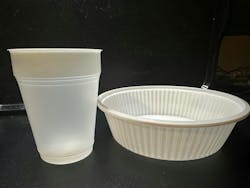By Bruce Geiselman
OMV Technologies, which designs and builds thermoforming machines, molds and extrusion in-line systems for rigid food packaging, highlighted its latest advancements in sustainability at NPE2024 in Orlando.
One of its most recent efforts is an alliance with Promix and its Microcell foaming technology.
“The technology results in a substantial reduction in part weight, coupled with insulative properties and excellent mechanical properties,” said Mark Strachan, VP of innovation and product development at OMV.
OMV has begun offering the Promix gassing system and real-time intrinsic viscosity (IV) monitoring as options for its extruders used for thermoforming. The technology also could be used for producing pipe and profile. This integration enables precise control over the gas injection process during production, ensuring consistent quality and reduced overall material usage.
The Promix gassing system precisely blends environmentally neutral and cost-effective nitrogen and carbon-dioxide gases to achieve the desired properties in the final product, while the real-time IV monitor continuously monitors the intrinsic viscosity of the material, providing instant feedback to maintain product consistency, Strachan said.
The gassing system adds a gas-filled foamed core that reduces the amount of plastic used, part weight and production costs. The technology is offered on new machines and can be retrofitted onto previously purchased OMV extruders.
The Promix system of injecting nitrogen and carbon dioxide into the material instead of relying on chemical foaming results in better-quality sheet for thermoforming and reduced production costs, Strachan said.
“A lot of times people have used a chemical foaming process, and they’ve got to add very expensive additives to it, and it becomes cost-prohibitive,” he said. “We find Promix to be a much better system because it’s a microcell, and it provides a really nice part that is easily thermoformable.”
Microcell foam extrusion systems from Promix are used for a wide variety of applications and for almost all polymers. The production of “very homogeneous microcellular foam structures” results in parts and thermoformable sheets with excellent mechanical properties, according to information from the Promix website.
This technology is particularly designed for applications where material quality and consistency are paramount, such as in the production of high-volume packaging, like medical or food trays.
The closed-cell foam structure in the center layer (the B layer of an ABA sheet structure) offers a lighter product with insulative properties for hot or cold cups and containers without compromising the product top load and hoop strength properties.
Top load and hoop strength properties are critical measures of a cup’s durability and structural integrity. When cups and tubs are tested for top load strength, a force is applied to the top of the cup to determine at what point the cup will collapse. Hoop strength, on the other hand, measures the force needed to squeeze a round cup into a non-round or oval shape.
The ability to accurately monitor the intrinsic viscosity of resin is particularly important when processors are working with post-consumer recycled content because the properties of such recycled material can vary significantly, Strachan said.
OMV Technologies also recently partnered with Avantium on developing polyethylene furanoate (PEF), a 100 percent plant-based resin. The recyclable bioplastic can be used as a high-barrier layer in multi-layer packaging and is compatible with PET.
OMV Technologies recently demonstrated the effectiveness of PEF ain multilayer packaging by producing on its thermoforming equipment a PET-based cup featuring a PEF barrier layer on both the outside and the inside. The addition of PEF layers offers a significant improvement in oxygen barrier properties to PET sheet.
OMV Technologies, West Palm Beach, Fla., 833-625-7872, www.omvtechnologies.com
About the Author
Bruce Geiselman
Senior Staff Reporter Bruce Geiselman covers extrusion, blow molding, additive manufacturing, automation and end markets including automotive and packaging. He also writes features, including In Other Words and Problem Solved, for Plastics Machinery & Manufacturing, Plastics Recycling and The Journal of Blow Molding. He has extensive experience in daily and magazine journalism.
